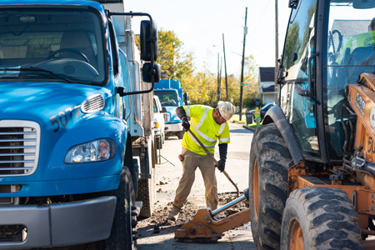Understanding The White House's Get The Lead Out Partnership, With One Of Its Participants

By Kevin Westerling,
@KevinOnWater

In late January, the White House welcomed over 100 organizations for the launch of the Biden-Harris Get the Lead Out Partnership, which seeks replacement of 100% of the nation’s lead service lines (LSLs) in 10 years. The organizations that were on hand come from various sectors, but all have a vested interest in ‘getting the lead out’ and improving water quality for consumers, and all have partnered with the Administration to achieve the lofty goal of complete LSL removal.
Among the partners is BlueConduit, which uses publicly available data to conduct lead pipe predictions, beginning in 2016 with Flint, Michigan. Since then, its software has supported over 100 communities in the U.S. and Canada to reduce the number of days residents live with the risk of lead exposure; and by April 2023, BlueConduit’s nationwide lead location predictions will be available on an interactive map, allowing the public to find out the status of their water systems.
I recently spoke with Sheela Lal, BlueConduit’s Public Sector Relationships Manager, about the company’s role in the Get the Lead Out Partnership, the obstacles to completing the mission, and the state of regulations around lead pipe infrastructure.
Lal holds a BS in Statistics and BA in International Studies from the University of Missouri and an MBA from the University of Michigan, and arrived at BlueConduit following a long and varied career working to empower community development. She worked in the Missouri political ecosystem for four years, built DEI (diversity, equity, and inclusion) strategy for the U.S. branch of the world’s largest IT services company, conducted research in Sri Lanka on a Fulbright Fellowship, and developed an external relations strategy for a Kolkata, India-based social enterprise.
Now, she’s using her expertise to benefit water utilities and consumers throughout the U.S. Here’s her insights on the lead issue and the White House plan of action.
Please describe how these diverse organizations — including states, municipalities, NGOs, water utilities, and technology companies — intend to come together to achieve the desired outcome?

We are all in this together.
Is a 10-year timeline to replace 100% of the nation’s lead service lines truly feasible? What could stand in the way of achieving that goal?
Whether or not 10 years is feasible, it is certainly ambitious. Ambitious goals allow all of the partners and stakeholders to come together to build innovative solutions, at scale.
We, alongside most organizations working to get the lead out, recognize that even with the historic Bipartisan Infrastructure Law cash infusion, it isn’t enough to get all of the known, let alone unknown, lead pipes.
On the other end of the spectrum, there are legal barriers to confirming lead service lines on the private side for water system employees, let alone replacing them.
More optimistically, what are the key actions from partners that will make this mission a success?
The White House has drawn together communities, groups, and businesses from across the country. Specifically, they are bringing over 100 water systems, states, nonprofits, and companies together.
The Guiding Principles created as part of this effort centers disadvantaged communities, encourages engagement with residents, and will accelerate the removal and replacement of lead pipes through sharing best practices.
A key contribution from partners will be the creation and sharing of best practices and case studies from cities across the country that have proactively removed lead or successfully demonstrated the absence of lead service lines.
What is BlueConduit's specific role and how does it fit into the plan?
We signed onto the Guiding Principles. Our expertise and experience lies in helping utilities estimate the scope of their lead service lines replacement, create an inventory with predictions for unknown materials, and communicate this information clearly to their residents. To do this, we use predictive modeling and data science. We were proud to see innovative data science mentioned in the Guiding Principles:
Promote utilization of innovative data, science, modeling, and mapping to guide lead mitigation and develop publicly accessible inventories.
If you look at the list of organizations that signed onto the Guiding Principles, you will see state governments, cities, non-profits, engineering firms, tech companies, and many other organizations committed to removing lead pipes from our drinking water system. No entity can do this alone, and we are proud to be part of that village working towards a goal of making our communities healthier.
How does this partnership and initiative relate to the Lead and Copper Rule Revisions?
The Lead and Copper Rule Revisions [LCRR] require water utilities to develop a service line inventory. Knowing where you have lead pipes is an essential step to being able to replace them. In that way, components of the LCRR and the guidance EPA released in August work in tandem with this effort to be able to remove all lead service lines in 10 years.
How will non-partner water utilities be involved?
The goal is to reduce barriers for all, remove lead from everywhere, not just in listed communities. The aim is to understand what solutions work in these communities and how we can implement a similar portfolio of options across the country to meet the Lead and Copper Rule compliance deadline and work quickly to abate lead exposure. Non-partner water utilities will benefit from guidance developed and case studies elevating best practices.
What can we expect to hear next with regard to progress, next steps, announcements, or requirements?
We anticipate a quarterly cadence of partnership activities, with more to come. We are in the beginning stages of this highly collaborative initiative, and really look forward to implementing all the solutions that we imagine together.
